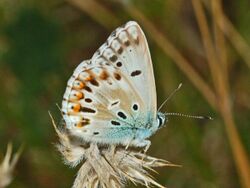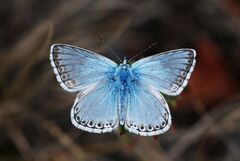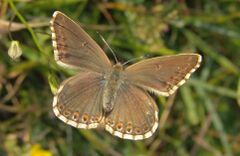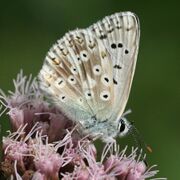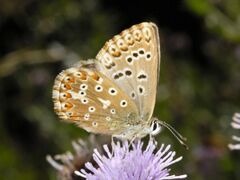Biology:Chalkhill blue
| Polyommatus coridon | |
|---|---|
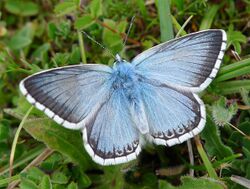
| |
| Male P. coridon | |
| Scientific classification | |
| Domain: | Eukaryota |
| Kingdom: | Animalia |
| Phylum: | Arthropoda |
| Class: | Insecta |
| Order: | Lepidoptera |
| Family: | Lycaenidae |
| Genus: | Polyommatus |
| Species: | P. coridon
|
| Binomial name | |
| Polyommatus coridon (Poda, 1761)
| |
| Synonyms | |
|
Lysandra coridon Poda, 1761 | |
The chalkhill blue (Polyommatus coridon) is a butterfly in the family Lycaenidae.
Subspecies
Subspecies include:[1]
- Polyommatus coridon coridon
- Polyommatus coridon borussia (Dadd, 1908) – (Urals)
- Polyommatus coridon asturiensis Sagarra, 1922 – (Spain )
Evolution
Sibling species
Upon using allozyme analyses when looking at the species P. hispana and P. slovacus showed a difference in evolutionary history with P. coridon.[2] The analysis showed that P. hispana has a large genetic distance between the two species and that there was allopartic speciation from P. coridon.[2] P. slovacus seems to show that there was sympatry with P. coridon but the genetic analysis could not prove this hypothesis, so the researchers made the conclusion that this particular species was a local population that has an atavism of bivoltinism.[2]
Post-glacial expansion
The expansion of the species travels from western Europe into eastern Europe from the ice-age refugium into the Balkans.[3] The starting point for the expansion is in western Hungary traveling into the Balkans and then into Brandenburg and Poland.[3] This expansion shows that are two routes due to the changes in gene allele frequencies and the degree of homogeneity of the species.[3]
The two routes are:[3]
1.) Starting in the western tip of Hungary traveling into north-eastern Hungry along the Hungarian Mountains into eastern Slovakia
2.) Starts in western Hungary and travels along the eastern Alps into western Slovakia and Czech Republic
The expansion caused there to be two unique genetic populations that were separated by mountain ranges. And the expansion also caused the movement of species that were only found in warmer areas to move into new habitats that were previously cooler in temperature and did not have the biotic components to support these new species.
Ecology
Description
Polyommatus coridon has a wingspan of 30–36 millimetres (1.2–1.4 in).[4] These small butterflies present a sexual dimorphism. This species' physical appearance can be described as males having pale silvery-blue upperside of the wings with a submarginal line of gray spots on the hindwings and a thin brown and white chequered fringe. Females have dark brown upperside of wings, with marginal orange spots and also with chequered fringes.[5] The underside of the wings show a light ocher colouration, several dark spots surrounded by white, a submarginal line of black marks, a series of marginal orange spots on the hindwings and a blue dusting near the body.
As with many blue butterflies, separation from similar species in the field is on the underside markings. Aberrations are common.[6]
Distribution
Geographical range
This species can be found in the Palearctic ecozone (west Europe, south Europe, central Europe, Asia Minor, south Urals, northwest Turan).[1] The range of P. coridon occurs throughout Central Europe, and is endemic to Europe.[7] There are a few exceptions to where it is located in Central Europe, it is not found in the countries of Ireland, Scotland, Scandinavia, the Netherlands, the Iberian Peninsula (exception of it being found in the northern provinces of Iberian), the Mediterranean islands (found in Corsica and Sardinia), and most of southern Italy.[7]
Habitat
This particular species of butterfly has a preference for dry calcareous grasslands, at an elevation of 100–2,000 metres (330–6,560 ft) above sea level.[4][8] This species also has a preference towards grasslands that have short grass with many flowering plant. P. coridon is a sedentary organism which means that they do not travel very far within their habitat range. These individuals have the tendency to stay within their habitat patch rather than do long migrations to find new habitats.[8]
Biology
Note that information on this species applies to Great Britain and some details may not be consistent with the species in other parts of its range.
This species only produces one generation per year making them a univoltine, which means that this species only breeds once per year and will only produce one set of offspring.[9]
P. coridon is monophagous, which means that they only feeds on one specific species of plant.[10] The larvae or caterpillars of this species feed on the leaves of horseshoe vetch (Hippocrepis comosa) upon which the larvae feed.[10][4]
When they are ready they pupate on the ground within the leaf litter of the host plants.[7]
The caterpillars are attend by several different ants of the genera Myrmica, Lasius, Formica, Plagiolepis, Tetramorium, Aphaenogaster and Tapinoma.[7][11]
This butterfly is usually seen on the wing from June to October.[4]
In the research into the effects of trophic interaction and fragmentation it was found that there are no known parasitoids that are specialized to this species, but there are other parasitoids that are related to other species that are part of the family Lycaenidae which will sometimes predate this species.[12] It could be a viable option that the parasitoids that did predate upon this species became extinct due to the fragmentation of their habitat in the past.[12]
Factors that affect genetic diversity
Habitat fragmentation
This would be physical features of the environment that separate populations of the same species.[13][14][15] One type of would be mountain ranges which separate west and east population of P. coridon, and this separation causes there to be changes in the allele frequency of both population and there can be mixing of these populations only when there is an area that is connected.[13][14]
Another type would be the loss of habitat which can lead to large habitat areas being fragmented, this loss can occur due to human interaction with the ecosystem in way that isolates populations of the species.[8][10][12][15] The loss of habitat changes the number of individuals that the area can support or blocks the population off from a larger population. The limiting number of individuals in the population or the isolation can cause a decrease in the heterogeneity of population and leads to a decrease in fitness.[8][10][12]
Habitat fragmentation causes conservation efforts to be difficult because it has to be decided what areas get protect or have the best possible chance of helping increase a population without damaging the overall fitness of the population, so great care is taken when selecting what areas will be protected.[13][14][15]
Status and conservation
Status
According to IUCN Red List for Threatened Species, this particular species is of Least Concern, and this is due to this species not having a significant decline in population in the last ten years, which would be a decline by 25% in the number of adults.[7]
Conservation
Since this species is of Least Concern there are few conservation efforts being put forth. But in certain areas that have been having large decline or had large decline implemented conservation efforts. This species is considered by researchers to be an indicator species of calcareous grassland habitat quality and could also be a good model organism to help develop conservation programs for more At Risk species.[8][10][16]
Conservation in the United Kingdom, Germany, and Poland
All three countries have done research into the conservation of the calcareous grassland. Protecting this species would also lead to helping protect higher trophic level individuals that are located in this ecosystem.[12]
United Kingdom
The chalkhill blue experienced a significant decline in population number in the 1950s.[8] There was a rise in population number from the time period of 1981-2000, in this time period there was a significant increase in population numbers and this increase lead to the stabilization of population number in the 1990s.[8] The UK Biodiversity Action Plan had monitoring plans in place to see these changes and the data that was collected during that time period showed that the increase in population number came from the use of controlling grazing levels, conservation designation, and agri-environment schemes entry and management.[8] These practices improved the quality of the habitats that were located in the United Kingdom.[8]
Germany and Poland
Both Germany and Poland came up with action plans such as that if conservation efforts where to take place that the ideal area for protection would be large habitats that were interconnected with other Grassland habitats that were fragmented, and had a high abundance of the juvenile host plant located within it or had the ability to support a large number of plants.[12][16]
Bibliography
- D.J. Carter (ill. B. Hargreaves), Guide des chenilles d'Europe, Paris, Delachaux & Niestlé, 2001 (ISBN:978-2-603-00639-9)
- Emmet, A.M. (1990) Lysandra coridon (Poda). Pages 160-162 in The Moths and Butterflies of Great Britain and Ireland Vol. 7 Part 1 (ed. A.M. Emmet and J. Heath). Harley Books, Colchester, UK.
- LepIndex: The Global Lepidoptera Names Index. Beccaloni G.W., Scoble M.J., Robinson G.S. & Pitkin B.
- Tom Tolman et Richard Lewington, Guide des papillons d'Europe et d'Afrique du Nord, Delachaux et Niestlé, 1997 (ISBN:978-2-603-01649-7)
- Tomlinson, D. and R. Still (2002) Britain's Butterflies. WildGuides, Old Basing, UK.
References
- ↑ 1.0 1.1 Funet
- ↑ 2.0 2.1 2.2 Schmitt, Thomas; Varga, Zoltán; Seitz, Alfred (2005-12-01). "Are Polyommatus hispana and Polyommatus slovacus bivoltine Polyommatus coridon (Lepidoptera: Lycaenidae)? The discriminatory value of genetics in taxonomy". Organisms Diversity & Evolution 5 (4): 297–307. doi:10.1016/j.ode.2005.01.001. http://www.sciencedirect.com/science/article/pii/S1439609205000462.
- ↑ 3.0 3.1 3.2 3.3 Schmitt, T.; Seitz, A. (2002-06-25). "Postglacial distribution area expansion of Polyommatus coridon (Lepidoptera: Lycaenidae) from its Ponto-Mediterranean glacial refugium" (in en). Heredity 89 (1): 20–26. doi:10.1038/sj.hdy.6800087. ISSN 0018-067X. http://www.nature.com/hdy/journal/v89/n1/full/6800087a.html.
- ↑ 4.0 4.1 4.2 4.3 Simon Coombes Captain's European Butterfly Guide
- ↑ Chalkhill Blue at Butterfly Conservation
- ↑ Matt Rowlings Euro Butterflies
- ↑ 7.0 7.1 7.2 7.3 7.4 "Polyommatus coridon". https://dx.doi.org/10.2305/IUCN.UK.2010-1.RLTS.T173211A6974668.en.
- ↑ 8.0 8.1 8.2 8.3 8.4 8.5 8.6 8.7 8.8 Brereton, Tom M.; Warren, Martin S.; Roy, David B.; Stewart, Katherine (2007-07-20). "The changing status of the Chalkhill Blue butterfly Polyommatus coridon in the UK: the impacts of conservation policies and environmental factors" (in en). Journal of Insect Conservation 12 (6): 629–638. doi:10.1007/s10841-007-9099-0. ISSN 1366-638X. https://link.springer.com/article/10.1007/s10841-007-9099-0.
- ↑ Schmitt, Thomas; Varga, Zoltán; Seitz, Alfred (2005-12-01). "Are Polyommatus hispana and Polyommatus slovacus bivoltine Polyommatus coridon (Lepidoptera: Lycaenidae)? The discriminatory value of genetics in taxonomy". Organisms Diversity & Evolution 5 (4): 297–307. doi:10.1016/j.ode.2005.01.001. http://www.sciencedirect.com/science/article/pii/S1439609205000462.
- ↑ 10.0 10.1 10.2 10.3 10.4 Krauss, Jochen; Schmitt, Thomas; Seitz, Alfred; Steffan-Dewenter, Ingolf; Tscharntke, Teja (2004-02-01). "Effects of habitat fragmentation on the genetic structure of the monophagous butterfly Polyommatus coridon along its northern range margin" (in en). Molecular Ecology 13 (2): 311–320. doi:10.1046/j.1365-294X.2003.02072.x. ISSN 1365-294X. http://onlinelibrary.wiley.com/doi/10.1046/j.1365-294X.2003.02072.x/abstract.
- ↑ Paolo Mazzei, Daniel Morel, Raniero Panfili Moths and Butterflies of Europe and North Africa
- ↑ 12.0 12.1 12.2 12.3 12.4 12.5 Brückmann, Sabrina V.; Krauss, Jochen; Achterberg, Cornelis van; Steffan-Dewenter, Ingolf (2010-11-26). "The impact of habitat fragmentation on trophic interactions of the monophagous butterfly Polyommatus coridon" (in en). Journal of Insect Conservation 15 (5): 707–714. doi:10.1007/s10841-010-9370-7. ISSN 1366-638X. https://link.springer.com/article/10.1007/s10841-010-9370-7.
- ↑ 13.0 13.1 13.2 Schmitt, Thomas; Seitz, Alfred (2001-09-01). "Allozyme variation in Polyommatus coridon (Lepidoptera: Lycaenidae): identification of ice-age refugia and reconstruction of post-glacial expansion" (in en). Journal of Biogeography 28 (9): 1129–1136. doi:10.1046/j.1365-2699.2001.00621.x. ISSN 1365-2699. http://onlinelibrary.wiley.com/doi/10.1046/j.1365-2699.2001.00621.x/abstract.
- ↑ 14.0 14.1 14.2 Schmitt, Thomas; Zimmermann, Marco (2012-05-01). "To hybridize or not to hybridize: what separates two genetic lineages of the Chalk-hill Blue Polyommatus coridon (Lycaenidae, Lepidoptera) along their secondary contact zone throughout eastern Central Europe?" (in en). Journal of Zoological Systematics and Evolutionary Research 50 (2): 106–115. doi:10.1111/j.1439-0469.2011.00644.x. ISSN 1439-0469. http://onlinelibrary.wiley.com/doi/10.1111/j.1439-0469.2011.00644.x/abstract.
- ↑ 15.0 15.1 15.2 Schmitt, Thomas; Seitz, Alfred (2002-10-01). "Influence of habitat fragmentation on the genetic structure of Polyommatus coridon (Lepidoptera: Lycaenidae): implications for conservation". Biological Conservation 107 (3): 291–297. doi:10.1016/S0006-3207(02)00066-6. http://www.sciencedirect.com/science/article/pii/S0006320702000666.
- ↑ 16.0 16.1 Rosin, Zuzanna M.; Skorka, Piotr; Moron, Dawid; Sparks, Tim H.; Tryjanowski, Piotr (2011). "Increasing patch area, proximity of human settlement and larval food plants positively affect the occurrence and local population size of the habitat specialist butterfly Polyommatus coridon (Lepidoptera: Lycaenidae) in fragmented calcareous grasslands". European Journal of Entomology 108: 99–106. doi:10.14411/eje.2011.013.
External links
- Kimmo Silvonen Larvae of North-European Lepidoptera
- Lepiforum.de
See also
- List of butterflies of Great Britain
Wikidata ☰ Q536956 entry
